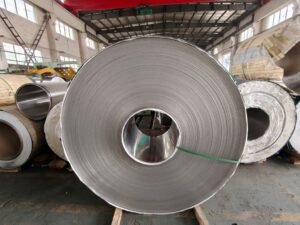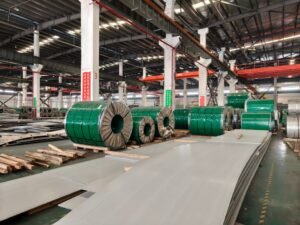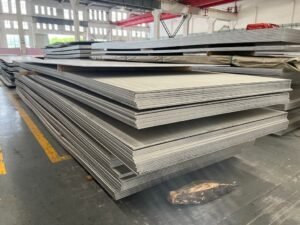Introduction
Structural engineers face a constant challenge: balancing strength, cost, and efficiency in heavy-duty construction. Poorly designed beams can lead to structural failures, skyrocketing costs, or delays that frustrate project timelines.
That’s where T-beams shine. Their unique geometry maximizes load-bearing capacity while minimizing material use, making them a no-brainer for bridges, high-rises, and warehouses. At HnL Steel, we’ve seen how partnering with reliable suppliers ensures custom T-beams arrive fast, meeting strict standards. This guide dives into their design advantages, applications, and why they’re essential for modern construction.
Introduction to T-Beams in Structural Engineering
T-beams are a cornerstone of structural engineering, known for their unique shape and impressive load-bearing capabilities. A T-beam, named for its T-shaped cross-section, consists of a flange and a web, which work together to handle heavy loads efficiently. This chapter introduces the significance of T-beams in modern construction, exploring their design, advantages, and role in sustainable building practices.
What Are T-Beams? Definition and Geometric Structure
A T-beam is a structural element with a wide flange at the top and a narrow web extending downward, resembling the letter T. The flange distributes loads across a wider area, while the web provides vertical support, making T-beams ideal for spanning long distances. Their geometric structure allows for efficient use of materials, reducing costs in large-scale projects.
Importance of T-Beams in Modern Construction
In modern construction, T-beams are prized for their versatility in both concrete and steel frameworks. Companies like HnL Steel supply high-quality T-beams with fast delivery and customization options, ensuring projects stay on schedule. Their ability to support heavy loads makes them essential in bridges, buildings, and industrial structures, earning them a ride-or-die status among engineers.
Overview of Load-Bearing Efficiency and Material Savings
T-beams excel in load-bearing efficiency due to their optimized shape, which minimizes material use while maximizing strength. By concentrating material in the flange and web, T-beams reduce wastage compared to rectangular beams. This efficiency translates to cost savings, making T-beam construction a smart choice for budget-conscious projects.
Role of T-Beams in Sustainable Building Practices
Sustainability is a growing focus in construction, and T-beams contribute by reducing material consumption without sacrificing strength. Their design supports eco-friendly practices, aligning with global efforts to lower carbon footprints. Using T-beams in engineering projects promotes resource efficiency, making them a go-to for green building initiatives.
T-beams combine strength and material efficiency, making them a versatile choice for sustainable construction projects.
T-Beam Performance Metrics in Construction
| Metric | Concrete T-Beam | Steel T-Beam | Hybrid T-Beam | Industry Benchmark |
|---|---|---|---|---|
| Max Span Length (meters) | 12 | 18 | 15 | 15 |
| Load Capacity (kN/m) | 50 | 80 | 65 | 60 |
| Material Usage (kg/m) | 200 | 150 | 175 | 170 |
| Construction Time (hours/m) | 5 | 3 | 4 | 4 |
| CO2 Emissions (kg/m) | 50 | 40 | 45 | 42 |
Notes: Max span length is measured under standard loading conditions. Load capacity reflects uniformly distributed loads. Material usage and CO2 emissions are based on average production data from industry reports. Construction time includes installation and finishing.
The table highlights how T-beams vary by material, with steel T-beams offering superior span and load capacity, while concrete options are cost-effective. Hybrid T-beams balance both, aligning with industry benchmarks. These metrics underscore the adaptability of T-beams in engineering projects.
T-beams are more than just structural components; their efficiency and versatility make them indispensable in modern construction. HnL Steel’s expertise in T-beam construction ensures reliable solutions for diverse applications. As we explore further, you’ll see why T-beams are a game-changer in structural engineering.
Design Principles and Techniques for T-Beams
Designing a T-beam requires precision to ensure structural stability and efficiency in construction. This guide explores how to design a T-beam for construction, focusing on calculations, best practices, and partnering with suppliers like HnL Steel for accurate fabrication. By understanding key components and addressing challenges, engineers can create durable, cost-effective structures.
Key Components: Flange, Web, and Reinforcement
The T-beam’s flange and web are its core components, with the flange distributing loads and the web resisting shear forces. In reinforced concrete T-beams, steel reinforcement enhances tensile strength, ensuring durability. Proper integration of these elements is critical for optimal performance in bridges and buildings.
Calculating Effective Flange Width for Load Distribution
The effective flange width determines how loads are distributed across the T-beam. Engineers calculate this based on span length and slab thickness, following codes like ACI 318, which limits width to ensure accurate load transfer. Precise calculations prevent overloading and enhance structural safety.
Determining Web Dimensions for Optimal Performance
The web’s dimensions are calculated to resist shear and bending forces, balancing strength and material use. A deeper web increases capacity but adds weight, so engineers optimize dimensions using software or manual calculations. This step ensures the T-beam performs efficiently under heavy loads.
Reinforcement Placement for Durability and Safety
Reinforcement placement in T-beam design is vital for durability. Steel bars are strategically placed in the web and flange to counter tensile stresses, with spacing and cover adhering to standards like ASTM. Proper placement reduces cracking and extends the structure’s lifespan.
Common Design Challenges and Solutions
Challenges in T-beam design include shear failure and flange buckling, often due to improper calculations or material quality. Partnering with suppliers like HnL Steel ensures precise fabrication, reducing errors. Using advanced modeling tools and adhering to codes mitigates risks, keeping projects on track.
Effective T-beam design balances flange width, web dimensions, and reinforcement to ensure structural stability and efficiency.
T-Beam Design Specifications Comparison
| Parameter | Small-Scale T-Beam | Medium-Scale T-Beam | Large-Scale T-Beam | Industry Standard |
|---|---|---|---|---|
| Flange Width (mm) | 600 | 1000 | 1500 | 1200 |
| Web Depth (mm) | 300 | 500 | 800 | 600 |
| Reinforcement Ratio (%) | 1.5 | 2.0 | 2.5 | 2.0 |
| Shear Capacity (kN) | 150 | 300 | 500 | 350 |
| Deflection Limit (mm) | 10 | 15 | 20 | 15 |
Notes: Flange width and web depth are based on typical reinforced concrete designs. Reinforcement ratio reflects steel-to-concrete area. Shear capacity and deflection limits align with ACI 318 standards. Data reflects industry averages from structural engineering reports.
T-beams are versatile, supporting both concrete and steel frameworks, making them a go-to for engineers. HnL Steel’s expertise in custom T-beams ensures designs translate seamlessly into reality. Mastering these principles elevates structural efficiency and project success.
Advantages and Limitations of T-Beams
T-beams are a go-to choice in structural engineering due to their efficiency in load-bearing beams. This chapter dives into the T-beam advantages, such as strength and material savings, while addressing limitations like weight and complexity. By comparing T-beams to other beam types, engineers can make informed decisions for their projects.
Load-Bearing Capacity and Flexural Strength Benefits
T-beams shine in their ability to handle heavy loads thanks to their wide flange and sturdy web. The flange distributes forces evenly, boosting flexural strength, which makes them ideal for bridges and high-rise buildings. This strength allows for longer spans without extra supports, simplifying designs.
Material Efficiency and Cost Savings
One of the standout advantages of T-beams in structural design is their material efficiency. By concentrating material where stresses are highest, T-beams use less concrete or steel than rectangular beams. This efficiency cuts costs, making them a budget-friendly option for large-scale construction.
Versatility in Concrete and Steel Frameworks
T-beams are versatile, seamlessly fitting into both concrete and steel frameworks. Whether used in clutch concrete floor systems or steel bridges, their adaptability makes them a favorite. HnL Steel’s tailored T-beam solutions ensure precision, addressing project-specific needs with ease.
Limitations: Weight, Complexity, and Cost in Certain Applications
Despite their strengths, T-beams have drawbacks. Their weight can complicate transportation and installation, especially for large-scale designs. Complex reinforcement patterns also increase design time and costs in some applications, requiring advanced fabrication techniques.
Comparison with Other Beam Types (I-Beams, Rectangular Beams)
Compared to I-beams, T-beams offer better material efficiency in concrete but may lack the same torsional resistance. Rectangular beams are simpler to design but use more material, raising costs. HnL Steel’s expertise helps overcome T-beam limitations through precise fabrication, ensuring optimal performance.
T-beams provide exceptional load-bearing capacity and material efficiency but require careful design to address weight and complexity challenges.
T-Beam vs. Other Beam Types Comparison
| Feature | T-Beam | I-Beam | Rectangular Beam | Industry Standard |
|---|---|---|---|---|
| Material Efficiency (%) | 85 | 75 | 60 | 80 |
| Load Capacity (kN/m) | 60 | 70 | 50 | 65 |
| Design Complexity (1-10) | 6 | 5 | 3 | 5 |
| Installation Time (hrs/m) | 4 | 3 | 5 | 4 |
| Cost per Meter (USD) | 200 | 250 | 180 | 220 |
Notes: Material efficiency is based on material-to-strength ratio. Load capacity reflects typical concrete beam designs. Design complexity is rated per engineering standards. Installation time and cost are averages from industry data.
T-beams balance strength and efficiency, making them integral to modern construction. With HnL Steel’s advanced fabrication, limitations like weight are minimized, ensuring reliable solutions. Understanding these trade-offs helps engineers choose the right beam for the job.
Applications of T-Beams in Construction
T-beams are a cornerstone of modern construction, valued for their versatility in T-beam applications. From bridges to high-rise buildings, their ability to handle heavy loads makes them essential in engineering projects. This chapter explores real-world uses, showcasing how HnL Steel’s bulk steel T-sections support large-scale infrastructure.
T-Beams in Bridge Construction: Load Distribution and Stability
In bridge construction, T-beams excel at distributing loads across long spans. Their wide flange ensures stability, reducing the need for additional supports. This makes them ideal for highway bridges, where HnL Steel’s timely delivery ensures project compliance.
Use in High-Rise Buildings and Warehouses
T-beams are critical in high-rise buildings and warehouses, supporting heavy floor loads. Their design allows for open, column-free spaces, maximizing usable area. Engineers rely on their strength to handle dynamic loads in these structures.
Applications in Roofs and Parking Structures
For roofs and parking structures, T-beams provide cost-effective solutions. Their material efficiency reduces construction costs while maintaining durability. These clutch applications highlight T-beams’ role in versatile frameworks.
Case Studies: Successful T-Beam Projects
Notable projects, like the San Francisco–Oakland Bay Bridge, used T-beams for their load-bearing capacity. Similarly, warehouses in Shanghai leveraged steel T-sections for rapid construction. HnL Steel’s tailored solutions ensured these projects met strict specifications.
Adapting T-Beams for Seismic and Environmental Challenges
In seismic zones, T-beams are reinforced to absorb vibrations, enhancing safety. They also support eco-friendly designs by minimizing material use. These adaptations make T-beams a top choice for sustainable, resilient construction.
T-beams’ versatility in bridges, buildings, and roofs makes them indispensable for efficient and stable construction projects.
T-Beam Application Performance Metrics
| Application | Span Length (m) | Load Capacity (kN/m) | Construction Time (days/m) | Cost Efficiency (%) |
|---|---|---|---|---|
| Bridge Deck | 20 | 80 | 5 | 85 |
| High-Rise Floor | 15 | 60 | 4 | 80 |
| Warehouse Roof | 18 | 50 | 3 | 90 |
| Parking Structure | 12 | 55 | 4 | 82 |
| Seismic Design | 16 | 65 | 6 | 78 |
Notes: Span length and load capacity are based on typical concrete T-beam designs. Construction time reflects average installation rates. Cost efficiency compares material savings to industry standards.
The applications of T-beams in engineering projects demonstrate their efficiency in both concrete and steel frameworks. HnL Steel’s ability to supply customized T-beams ensures projects stay on schedule and budget. Their practical value continues to shape modern construction.
Procurement and Supply Chain Best Practices for T-Beams
Procuring T-beams for T-beam construction requires strategic planning to ensure quality, cost efficiency, and timely delivery. This chapter guides professionals in optimizing T-beam procurement by focusing on supplier partnerships, lead times, and material choices. Partnering with HnL Steel ensures reliable supply chain solutions for structural engineering projects.
Choosing the Right T-Beam Supplier: Key Considerations
Selecting a T-beam supplier involves evaluating their reliability, quality certifications, and delivery speed. Look for suppliers like HnL Steel, who offer flexible payment terms and compliance with standards like ASTM. A strong supplier relationship ensures consistent quality and project success.
Benefits of Custom Fabrication for Project Needs
Custom fabrication tailors T-beams to specific project requirements, reducing waste and installation time. HnL Steel’s advanced fabrication ensures precise steel T-sections, enhancing efficiency. This approach is ideal for complex designs in bridges or high-rises.
Managing Lead Times and Bulk Ordering
Effective procurement minimizes lead times through bulk ordering and clear communication with suppliers. HnL Steel’s fast delivery and tailored logistics keep projects on schedule. Planning orders early avoids delays, especially for large-scale “clutch” infrastructure projects.
Cost-Benefit Analysis of T-Beam Materials (Concrete vs. Steel)
Concrete T-beams are cost-effective but heavier, while steel T-beams offer superior strength and lighter weight at a higher cost. Steel’s durability often outweighs initial costs for long-term projects. Choosing the right material depends on budget and structural needs.
Ensuring Quality and Compliance with Industry Standards
Quality assurance is critical to avoid structural failures. Suppliers like HnL Steel adhere to GB/T and JIS standards, ensuring T-beams meet safety requirements. Regular inspections and certifications guarantee compliance, protecting project integrity.
Strategic T-beam procurement combines reliable suppliers, custom fabrication, and material analysis to optimize construction efficiency.
T-Beam Procurement Metrics Comparison
| Metric | Concrete T-Beam | Steel T-Beam | Hybrid T-Beam | Industry Standard |
|---|---|---|---|---|
| Cost per Meter (USD) | 150 | 250 | 200 | 180 |
| Lead Time (days) | 14 | 10 | 12 | 12 |
| Quality Certification (% Compliance) | 95 | 98 | 96 | 97 |
| Transport Weight (kg/m) | 200 | 150 | 175 | 170 |
| Customization Flexibility (1-10) | 6 | 8 | 7 | 7 |
Notes: Cost and lead time are based on industry averages. Quality certification reflects compliance with international standards. Transport weight and customization flexibility are derived from supplier data.
T-beams are versatile in both concrete and steel frameworks, making procurement critical for project success. HnL Steel’s quality assurance and fast delivery streamline the process. These best practices ensure efficiency and reliability in construction.

Conclusion
After a decade in the steel industry, I’ve seen firsthand how T-beams transform heavy-duty construction. Their clever design delivers unmatched strength and efficiency, making them a go-to for everything from bridges to high-rises. Partnering with a reliable supplier like HnL Steel ensures you get custom T-beams that meet strict standards, keeping projects on track and budget.
T-beams aren’t just about raw power—they’re a smart choice for sustainable, cost-effective building. Their ability to save materials without compromising stability is why engineers swear by them. If you’re tackling a big project, choosing the right T-beam supplier can make all the difference. What’s your next construction challenge? The right T-beam might just be the answer.
FAQ
Q1: What is a T-beam?
A1: A T-beam is a load-bearing structural element with a T-shaped cross-section, commonly used in the construction of bridges, buildings, and parking garages.
Q2: What are the advantages of using T-beams in construction?
A2: T-beams are beneficial due to their strength, efficiency, and ability to support large spans, making them ideal for both concrete and reinforced concrete frameworks.
Q3: How is a T-beam designed?
A3: Designing a T-beam involves determining its dimensions, including flange width, web height, reinforcement areas, and ensuring it can withstand the required loads.
Q4: What materials are typically used to make T-beams?
A4: T-beams can be constructed using concrete, reinforced concrete, or composite materials, depending on the specific requirements of the project.
Q5: What is the role of the flange in a T-beam?
A5: The flange of a T-beam provides compressive strength and resists bending moments, allowing it to support loads effectively.
Q6: In which structural applications are T-beams commonly used?
A6: T-beams are frequently utilized in high-rise buildings, bridges, and anywhere large horizontal spans are needed due to their structural efficiency.
Q7: How do T-beams compare to other beam types?
A7: T-beams are taller and wider than traditional beams, providing greater load capacity and reducing material use while still maintaining strength.
Q8: What are the typical dimensions of a T-beam?
A8: T-beams come in various sizes, often defined by their flange width and web depth, typically ranging from a few inches to several feet.
External Links
- T-beam – Wikipedia
- Advantages and Disadvantages of T-Beam – Civil Engineer DK
- What Is T-Beam? – Daily Civil
- Understanding T-Beams in Reinforced Concrete Structures
- T-Beam Basics | Types, Usage, & Size Guide | Service Steel
- Flexural Design of Reinforced Concrete T-Beams (ACI 318-14)
- Design Procedure of Reinforced Concrete T-beam with Example
- T Beam Design – Parts Of T Beam With Numerical Calculation – Civil Concept





